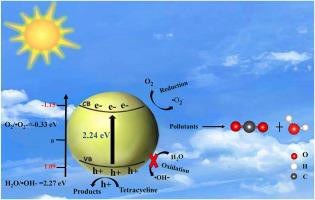掺锡biio微球增强抗生素降解的光活性
IF 4.6
3区 工程技术
Q2 ENGINEERING, ELECTRICAL & ELECTRONIC
引用次数: 0
摘要
四环素等抗生素的广泛使用,由于其在天然水系统中的持久性,对环境可持续性和公众健康造成了重大风险。本研究通过简单的一步水热法成功合成了sn掺杂的BiOI微球,实现了四环素在水溶液中的强化光降解。经过40 min的可见光照射,最佳的掺锡biio光催化剂对四环素的降解效率达到了82.8%,明显超过了纯biio的56.0%。为了了解催化行为增强的原因,采用XRD、SEM、XPS、UV-Vis DRS、PL和电化学等一系列表征技术,研究了催化剂的晶体结构、形貌、表面状态、光吸收性能、载流子重组和分离动力学。这些分析表明,锡的掺杂极大地改变了BiOI的微观结构、形貌和光学性质,从而大大提高了其光催化效率。进一步分析表明,锡掺杂效应显著增强了BiOI微球内光载流子的传输和分离,从而大大提高了在可见光下的光催化性能。本文章由计算机程序翻译,如有差异,请以英文原文为准。

Enhanced photoactivity of Sn-doped BiOI microspheres for antibiotic degradation
The widespread use of antibiotics such as tetracycline has led to significant risks to both environmental sustainability and public health due to their persistence in natural water systems. In this study, Sn-doped BiOI microspheres were successfully synthesized through a simple one-step hydrothermal method to achieve enhanced photodegradation of tetracycline in aqueous solution. After 40 min of visible light irradiation, the optimal Sn-doped BiOI photocatalyst exhibited an exceptional tetracycline degradation efficiency of 82.8 %, significantly surpassing the 56.0 % efficiency of pure BiOI. To understand the origins of the enhanced catalytic behavior, a series of characterization techniques, including XRD, SEM, XPS, UV–Vis DRS, PL, and electrochemical measurements, were performed to investigate the crystal structure, morphology, surface states, light absorption properties, and charge carrier recombination and separation dynamics of the catalysts. These analyses demonstrated that Sn doping substantially modified the microscopic structure, morphology, and optical properties of BiOI, thereby greatly improving its photocatalytic efficiency. Further analysis of Sn doping effects demonstrated significant enhancement in transport and separation of photocarriers within BiOI microspheres, thereby leading to substantially improved photocatalytic performance under visible light.
求助全文
通过发布文献求助,成功后即可免费获取论文全文。
去求助
来源期刊

Materials Science in Semiconductor Processing
工程技术-材料科学:综合
CiteScore
8.00
自引率
4.90%
发文量
780
审稿时长
42 days
期刊介绍:
Materials Science in Semiconductor Processing provides a unique forum for the discussion of novel processing, applications and theoretical studies of functional materials and devices for (opto)electronics, sensors, detectors, biotechnology and green energy.
Each issue will aim to provide a snapshot of current insights, new achievements, breakthroughs and future trends in such diverse fields as microelectronics, energy conversion and storage, communications, biotechnology, (photo)catalysis, nano- and thin-film technology, hybrid and composite materials, chemical processing, vapor-phase deposition, device fabrication, and modelling, which are the backbone of advanced semiconductor processing and applications.
Coverage will include: advanced lithography for submicron devices; etching and related topics; ion implantation; damage evolution and related issues; plasma and thermal CVD; rapid thermal processing; advanced metallization and interconnect schemes; thin dielectric layers, oxidation; sol-gel processing; chemical bath and (electro)chemical deposition; compound semiconductor processing; new non-oxide materials and their applications; (macro)molecular and hybrid materials; molecular dynamics, ab-initio methods, Monte Carlo, etc.; new materials and processes for discrete and integrated circuits; magnetic materials and spintronics; heterostructures and quantum devices; engineering of the electrical and optical properties of semiconductors; crystal growth mechanisms; reliability, defect density, intrinsic impurities and defects.
 求助内容:
求助内容: 应助结果提醒方式:
应助结果提醒方式:


